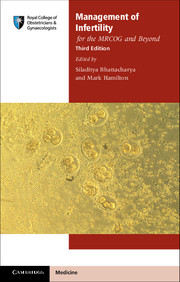Book contents
- Frontmatter
- Contents
- About the authors
- Preface
- Acknowledgements
- Abbreviations
- 1 Epidemiology and initial assessment
- 2 Male factor infertility
- 3 Ovulatory disorders
- 4 Tubal infertility
- 5 Endometriosis-related infertility
- 6 Uterine factors in infertility
- 7 Unexplained infertility
- 8 Assisted reproduction – preparation and work-up of couples
- 9 Assisted reproduction – clinical and laboratory procedures
- Index
6 - Uterine factors in infertility
Published online by Cambridge University Press: 05 June 2014
- Frontmatter
- Contents
- About the authors
- Preface
- Acknowledgements
- Abbreviations
- 1 Epidemiology and initial assessment
- 2 Male factor infertility
- 3 Ovulatory disorders
- 4 Tubal infertility
- 5 Endometriosis-related infertility
- 6 Uterine factors in infertility
- 7 Unexplained infertility
- 8 Assisted reproduction – preparation and work-up of couples
- 9 Assisted reproduction – clinical and laboratory procedures
- Index
Summary
Introduction
Uterine factor infertility can be defined as the presence of structural or functional pathology in the uterus that can reduce fertility and diminish the chance of conceiving through assisted reproductive technology (ART) techniques. Embryo implantation, one of the most critical steps in ART, is a complex process that depends on the interplay between the embryo and the endometrium. Surgical management of uterine pathology could therefore be expected to influence the outcome of in vitro fertilisation (IVF) treatment. However, the literature in this regard is largely based on individual experience and observational studies rather than randomised controlled trials (RCTs).
Aetiology
The aetiology of uterine factor infertility can be broadly classified into two categories:
• Congenital uterine anomalies result from a defect in the development or fusion of the paired müllerian ducts. Usually these abnormalities are mediated by a polygenic mechanism, although it is recognised that some occur sporadically.
• Acquired uterine abnormalities include endometrial polyps, fibroids and adenomyosis. Intrauterine adhesions can occur after infections (commonly associated with endometrial curettage, such as following miscarriage or postpartum haemorrhage) or surgery (open or hysteroscopic myomectomy, resection of uterine septum and caesarean section).
Congenital uterine anomalies
The prevalence of congenital uterine anomalies is 6.7% in the general population and 7.3% in the infertile population. The most common anomaly is the septate uterus, with a prevalence of 3.9% in infertile women, followed by arcuate and bicornuate uteri. Women with septate uteri have reduced conception rates and increased risks of first-trimester miscarriage, preterm birth and malpresentation at delivery.
Keywords
- Type
- Chapter
- Information
- Management of Infertility for the MRCOG and Beyond , pp. 67 - 76Publisher: Cambridge University PressPrint publication year: 2014

